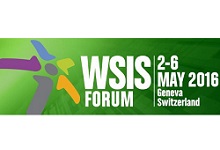ICT statistics in support of the 2030 agenda
2 May 2016 14:30h
Event report
[Read more session reports and live updates from the WSIS Forum 2016]
Organised by the Partnership on Measuring ICT for Development, the session presented an overview and assessment of statistics in relation to the sustainable development goals (SDGs).
The session’s moderator, Dr Cosmas Zavazava (Chief of Department, Project Support and Knowledge Management from ITU) stressed the importance of reliable statistics and the multistakeholder approach in measuring progress to keep up with the 2030 agenda, and to enable policymakers to address their policies.
Dr Susan Teltscher (Human Capacity Building Division and Acting Head in the ICT Data and Statistics Division, ITU) highlighted some measurement challenges, including the large number of indicators, resource constraints, data quality, and the many stakeholders that make the process even more complex than it already is. She pointed out, however, that last March, the UNSC (United Nations Statistical Commission) agreed with the proposed Global Indicator Framework. The UNSC indicated that statistics should primarily be based on national and official ones and acknowledged the role of ICT as an enabler for achieving and monitoring the SDGs. It also requested the Partnership on Measuring ICT for Development to report back on the measurement of the indicators in 2018. Furthermore, she presented the progress made by the Inter-Agency Expert Group on SDG Indicators (IAEG-SDGs) in establishing a tier system that classifies the 231 SDG indicators into three categories, based on their robustness and the availability of data.
Teltscher presented the SDGs and targets that were given an ICT-related indicator according to the Global Indicator Framework: SDGs 4, 5, 9, 17.6, and 17.8. For each of the goals, she explained the indicator’s robustness and data availability, as well as the efforts made by the ITU to measure five of the indicators.
Teltscher concluded her presentation with the challenges in relation to monitoring the SDGs according to the newly established framework. She first urged an increase in data availability by strengthening local statistical capacities and including ICT statistics in National Statistical Development Strategies (NSDS). She also recommended exploring new data sources (particularly Big Data) through the UN Global Working Group on Big Data and ITU initiatives.
Ms Scarlett Fondeur (Economic Affairs Officer, ICT Analysis Section at UNCTAD) explained the activities of the Partnership on Measuring ICT for Development, which submitted a joint proposal for SDG Indicators last year. The recently established SDG Indicator Framework only adopted a few of the Partnership’s proposed indicators, as it had to make choices based on feasibility and availability. The current framework excludes some proposed indicators, newly developed indicators, and new sources of data. Fondeur proposed to group the indicators thematically, rather than by SDG, to make the monitoring more comprehensive, and that the ‘excluded’ indicators should continue to be measured to have a full picture of the progress made.
Mr Martin Schaaper (Head, Science, Technology and Innovation Statistics (STI) Unit and the Communication and Information Statistics Unit, from the UNESCO Institute for Statistics (UIS)) presented the STI Indicators in the Global SDG Indicator Framework. Schaaper reminded the audience that the development of STI is important to achieve the SDGs. This importance has been recognised by the Addis Ababa Action Agenda, which addresses STI issues more comprehensively. He agreed with Fondeur that the monitoring of both STI and ICT indicators needs to be done thematically, based on the text of the Addis Ababa Action Agenda, to understand the full scope of progress made towards sustainable development. The monitoring of thematic indicators should furthermore be done through the collaboration between different UN agencies, possibly in cooperation with the IAEG-SDGs. Mr Taeke Gjaltema (Statistical Management and Modernisation Unit, Statistical Division, UNECE) talked about new data sources for monitoring progress towards SDGs, including big data, administrative data, and non-official sources. His presentation focused on the use of big data to measure SDG indicators. Although challenges remain concerning the coverage, representativeness, comparability, multivariate analysis, and the skills and technology needed for big data studies, big data has great potential for the measurement of the SDGs in general and the information society in particular. He furthermore mentioned the establishment of the Global Working Group on Big Data and the collaborative platform for big data analysis operated by UNECE.
The discussion with the audience focused on some of the core challenges in measuring SDG indicators, including the difficulties in comparing data obtained in different countries, the need for capacity development for governments that lack sufficient human and financial resources, and the question of consumers’ privacy and rights when accessing their data through big data analysis. Panellists and participants addressed the issue of disaggregated data. In relation to the goal of ‘leaving no one behind’, data needs to be disaggregated by gender, location, and vulnerable or marginalised groups in society, which adds complexity. This challenge will be addressed by the newly established Working Group on Data Disaggregation.
Zavazava concluded the session by saying that ‘big data is good, but smart data is better.’ The value that we get out of data is the most important thing. We must work together to extract something that is usable. We can achieve comparable measurement if we work together, not just among governments, but with all stakeholders.
by Ines Hfaiedh and Barbara Rosen Jacobson
Related topics
Related event

